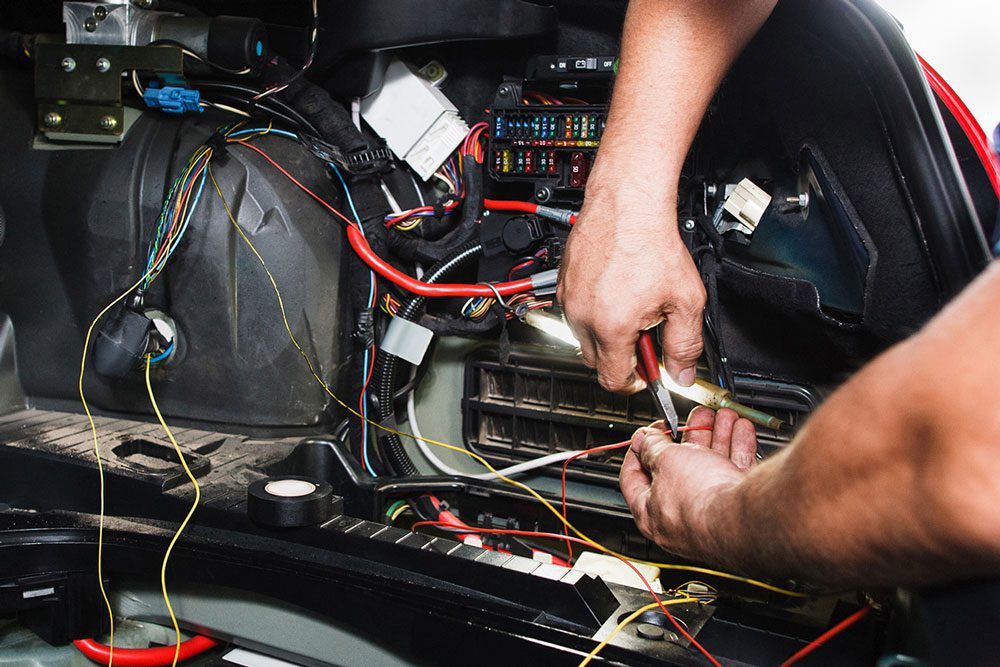Can I Install a Remote Starter Myself? (DIY Installation)
While the idea of installing a remote starter yourself might seem appealing, especially for those who are comfortable working on their vehicles, it’s a complex task that requires specialized knowledge and tools.
If you aren’t experienced installing electronics in your vehicle, we would recommend stopping here and finding an Authorized Remote Start Installer near you.
If you are hoping to buy a remote starter kit online and install it yourself, here are some of the risks and considerations involved:
Potential Risks of DIY Remote Start Installation

- Wiring Mistakes: Incorrect wiring can lead to a variety of problems, including electrical shorts, component damage, and even vehicle fires.
- Security System Interference: Remote starters can interfere with vehicle security systems, potentially leaving your car vulnerable to theft.
- Warranty Voidance: While aftermarket products are protected under the Magnuson-Moss Warranty Act, you may risk your vehicle’s warranty if you mistakenly damage a component in your vehicle. This could cause headache down the road if you need to file a warranty claim with your vehicle’s manufacturer.
- Complex Installation: Modern vehicles have sophisticated electronic systems. A misstep during installation can cause serious damage.
Why Professional Installation is Recommended
Remote start manufacturers like Compustar recommend professional installation when it comes to our products. That is because the installers at our Authorized Dealers have the expertise and experience to do the following on a wide array of vehicles.

- Properly Wire the System: They know the exact wiring diagrams and can connect everything correctly. Professional installers will also know how to properly route wire harnesses in order to avoid clutter under your dashboard.
- Clean Disassembly and Reassembly of Your Vehicle: They know how to take a part of a vehicle’s dashboard without damaging any of the plastics, which are expensive to replace. Furthermore, they will make sure your vehicle is returned good as new after your system is installed.
- Avoid Security System Conflicts: They can configure the remote starter to work seamlessly with your vehicle’s security system.
- Ensure Warranty Compliance: They know how to install the remote starter without voiding your vehicle’s warranty.
- Troubleshoot Issues: If any problems arise after installation, they can quickly diagnose and fix them.
Additionally, most DIY remote starter kits offer limited functionality and won’t enhance your life the way a Compustar remote starter will. Compustar offers premium remote transmitters that are capable of up to 3-miles of remote start range so that you can warm up and cool down your vehicle from virtually anywhere. As an added bonus, all of our systems are compatible with our award-winning smartphone app, DroneMobile, which adds unlimited range vehicle control and GPS tracking to your vehicle.
Understanding the Installation Process
Even if you’re considering professional installation, it’s helpful to understand the general steps involved in installing a remote starter in a modern vehicle:
- Vehicle Diagnosis: The installer will need to diagnose your vehicle’s electronic system to determine the best way to integrate the remote starter.
- Component Installation: This involves installing the remote starter’s main control module, antenna, and other components in various locations within the vehicle.
- Configuration for Specific Vehicles: Compustar remote starters offer vehicle-specific firmware in order to integrate with your vehicle’s internal computer. This allows our systems to control more components like sliding doors, trunk, and rear defrost.
- Wiring Harness Installation: The installer will need to carefully wire the remote starter’s components to your vehicle’s electrical system.
- Programming the Remote Starter: This step involves programming the remote starter to communicate with your vehicle’s computer system.
- Testing and Calibration: The installer will need to test all the remote starter’s functions, including starting the engine, locking and unlocking the doors, and activating the alarm system.
The Role of T-Harnesses
Many modern remote starter kits come with a T-harness, a specialized wiring harness that simplifies the installation process by splicing into existing factory connectors. While T-harnesses can reduce the complexity of wiring, they still require careful installation and can pose risks if not handled properly. Removing vehicle panels and disconnecting factory connectors, especially those related to the starter system, can be delicate and requires a steady hand and a good understanding of your vehicle’s electrical system.
Conclusion

While it’s possible to install a remote starter yourself, it’s generally not recommended unless you have extensive experience with automotive electronics. The potential risks far outweigh the potential savings. For most people, it’s best to leave the installation to a qualified professional.
After all, you want a remote starter to enjoy comfort on the road. And the last thing you want to see under your dashboard is a situation like this:

If you are interested in purchasing and installing a remote starter for your vehicle, try the Compustar System Builder of find an authorized dealer near you for pricing.




